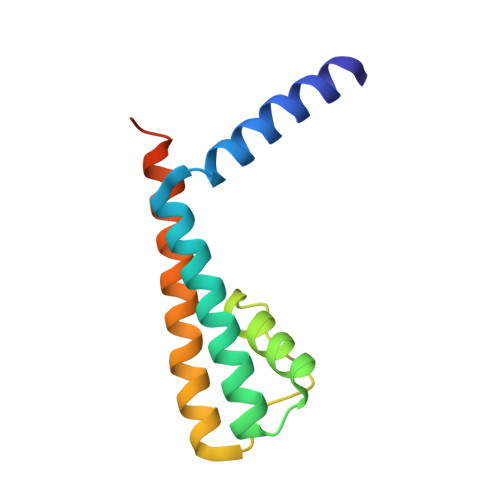Structural insight into Ca2+ specificity in tetrameric cation channels.
Alam, A., Shi, N., Jiang, Y.(2007) Proc Natl Acad Sci U S A 104: 15334-15339
- PubMed: 17878296
- DOI: https://doi.org/10.1073/pnas.0707324104
- Primary Citation of Related Structures:
2Q67, 2Q68, 2Q69, 2Q6A - PubMed Abstract:
Apparent blockage of monovalent cation currents by the permeating blocker Ca(2+) is a physiologically essential phenomenon relevant to cyclic nucleotide-gated (CNG) channels. The recently determined crystal structure of a bacterial homolog of CNG channel pores, the NaK channel, revealed a Ca(2+) binding site at the extracellular entrance to the selectivity filter. This site is not formed by the side-chain carboxylate groups from the conserved acidic residue, Asp-66 in NaK, conventionally thought to directly chelate Ca(2+) in CNG channels, but rather by the backbone carbonyl groups of residue Gly-67. Here we present a detailed structural analysis of the NaK channel with a focus on Ca(2+) permeability and blockage. Our results confirm that the Asp-66 residue, although not involved in direct chelation of Ca(2+), plays an essential role in external Ca(2+) binding. Furthermore, we give evidence for the presence of a second Ca(2+) binding site within the NaK selectivity filter where monovalent cations also bind, providing a structural basis for Ca(2+) permeation through the NaK pore. Compared with other Ca(2+)-binding proteins, both sites in NaK present a novel mode of Ca(2+) chelation, using only backbone carbonyl oxygen atoms from residues in the selectivity filter. The external site is under indirect control by an acidic residue (Asp-66), making it Ca(2+)-specific. These findings give us a glimpse of the possible underlying mechanisms allowing Ca(2+) to act both as a permeating ion and blocker of CNG channels and raise the possibility of a similar chemistry governing Ca(2+) chelation in Ca(2+) channels.
Organizational Affiliation:
Department of Physiology, University of Texas Southwestern Medical Center, Dallas, TX 75390-9040, USA.
















